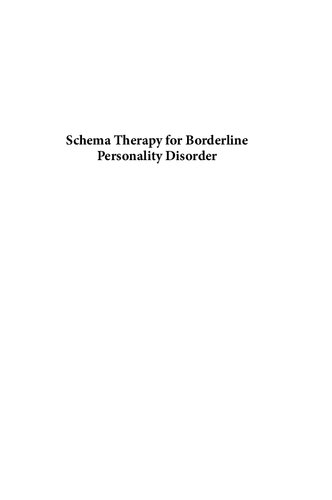

Most ebook files are in PDF format, so you can easily read them using various software such as Foxit Reader or directly on the Google Chrome browser.
Some ebook files are released by publishers in other formats such as .awz, .mobi, .epub, .fb2, etc. You may need to install specific software to read these formats on mobile/PC, such as Calibre.
Please read the tutorial at this link. https://ebooknice.com/page/post?id=faq
We offer FREE conversion to the popular formats you request; however, this may take some time. Therefore, right after payment, please email us, and we will try to provide the service as quickly as possible.
For some exceptional file formats or broken links (if any), please refrain from opening any disputes. Instead, email us first, and we will try to assist within a maximum of 6 hours.
EbookNice Team

Status:
Available5.0
40 reviews(Ebook) Schema therapy for borderline personality disorder 2nd Edition by Hannie van Genderen, Arnoud Arntz - Ebook PDF Instant Download/Delivery: 9781119101147 ,111910114X
Full download (Ebook) Schema therapy for borderline personality disorder 2nd Edition after payment
Product details:
ISBN 10: 111910114X
ISBN 13: 9781119101147
Author: Hannie van Genderen, Arnoud Arntz
Provides clear guidance on utilizing Schema Therapy to reduce BPD symptoms and bring about lasting changes in the patient's personality
People with Borderline Personality Disorder (BPD) struggle with a range of problems that negatively impact virtually every aspect of their lives, such as constantly changing moods, blurred personal identities, impulsive behaviors, interpersonal problems, and episodes of rage. BPD patients are at high risk of self-harm and substance abuse, with approximately 10% of BPD patients dying from suicide. BPD severely affects the education, employment, personal relationships, and physical and emotional wellbeing of those suffering from the disorder. Schema Therapy (ST), based on cognitive behavioral therapy and techniques derived from experiential therapies, has been shown to achieve substantial personality improvements in BPD patients.
Shema Therapy for Borderline Personality Disorder describes the pioneering BPD therapy based on insights from cognitive, behavioral, psychodynamic, humanistic, and developmental theories. Schema Therapy emphasizes the emotional processing of traumatic experiences and the use of the therapeutic relationship to bring about positive change. The text describes ST treatment for BPD in detail, covering the aims and phases of the therapy, treatment planning, cognitive and behavioral methods, specific techniques appropriate to each schema mode, behavioral pattern-breaking, termination of therapy, and more. This authoritative volume:
Schema Therapy for Borderline Personality Disorder is essential reading for clinical psychologists, psychotherapists, psychopathologists, psychiatrists, mental health practitioners, and advanced undergraduate and graduate students in relevant fields.
(Ebook) Schema therapy for borderline personality disorder 2nd Edition Table of contents:
1 Borderline Personality Disorder
What Is Borderline Personality Disorder?
Prevalence and Comorbidity
Development of BPD
2 Schema Therapy for Borderline Personality Disorder
The Development of Schema Therapy for Borderline Personality Disorder
Research Results
(Contra‐) Indications
Rationale of Treatment/Theories Supporting Treatment
Schema Modes
Summary
3 Treatment
Structure of Treatment
Phases in Treatment
Frequently Asked Questions About Treatment
4 The Therapeutic Relationship
Limited Reparenting
Therapists' Schemas
Self‐Disclosure
Cognitive Techniques and the Therapeutic Relationship
Behavioral Techniques and the Therapeutic Relationship
Summary
5 Experiential Techniques
Imagery
Imagery Rescripting
Imagery Rescripting in the Final Phase of Treatment
Imagery Rescripting: Changing Behavior Patterns in the Future
Frequently Asked Questions About Imagery Rescripting
Role Play
Two‐or‐More‐Chair Technique
Experiencing and Expressing Emotions
Experiencing and Expressing Other Emotions
Frequently Asked Questions About Experiential Techniques in General
Conclusion
6 Cognitive Techniques
The Socratic Dialogue
Evaluation on a Visual Analogue Scale
Multidimensional Evaluation
Two‐Dimensional Reproductions of Supposed Connections
Pie Chart
Courthouse Method
Historical Testing
Self Monitoring Circle
Flashcards
Positive Logbook
Frequently Asked Questions About Cognitive Techniques
7 Behavioral Techniques
Experiments
Skills Training and Role Play
Problem Solving
Discussing Dangerous Behaviors
Discussing New Behaviors
Frequently Asked Questions About Behavioral Techniques
8 Specific Methods and Techniques
Homework
Pharmacological Therapy
Crisis
Suicide and Self‐Injury
Trauma Processing
Frequently Asked Questions About Processing Traumas
9 Methods per Mode
Treatment Methods for the Detached Protector
Treatment Methods for the Abandoned/Abused Child
Treatment Methods for the Happy Child
Treatment Methods for the Angry Child
Treatment Methods for the Undisciplined/Impulsive Child
Treatment Methods for the Punitive Parent
Treatment Methods for the Healthy Adult
A Simultaneous Chess Play in a Pinball Machine
10 Schema Therapy in Other Settings and Modalities
Schema Therapy in Day‐Treatment and Inpatient Settings
Schema Therapy and Nonverbal Therapies
Group Schema Therapy
Schema Therapy for Couples
Summary
11 Final Phase of Therapy
Behavioral Pattern‐Breaking
Ending Therapy
12 Conclusion
Appendix A: Brochure for Patients: Schema Therapy for People with Borderline Personality Disorder
What Is Borderline Personality Disorder?
What Is Schema Therapy?
Description of BPD from the Perspective of Schema Therapy
Goal of Schema Therapy
Appendix B: Cognitive Diary for Modes
Appendix C: Positive Logbook
Appendix D: Historical Testing
Appendix E: Experiments
Appendix F: Homework Form
Appendix G: Problem Solving
Appendix H: Changing Behavioral Patterns
Appendix I: Eighteen Schemas
Disconnection and Rejection
Impaired Autonomy and Performance
Impaired Limits
Other‐Directedness
Overvigilance and Inhibition
Appendix J: Coping Strategies
Surrender (Schema‐Affirming Behavior: Freeze)
Avoidance (Schema‐Evasive Behavior: Flight)
Overcompensation (Showing the Opposite Behavior in Order to Fight the Schema: Fight)
Appendix K: Form for the Historical Role Play
References
Index
People also search for (Ebook) Schema therapy for borderline personality disorder 2nd Edition:
schema therapy for borderline personality disorder book
schema therapy for borderline personality disorder second edition
schema therapy for borderline personality disorder arntz
schema focused therapy for borderline personality disorder
schema therapy vs dbt for bpd
Tags: Hannie van Genderen, Arnoud Arntz, Schema therapy, borderline personality disorder